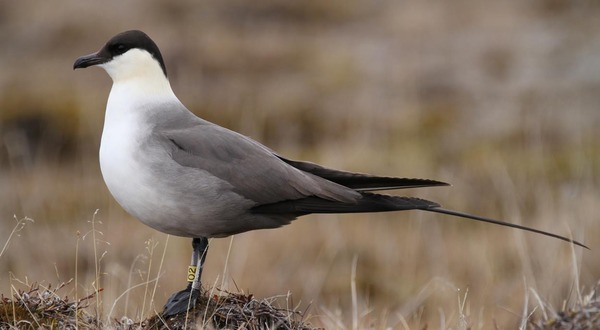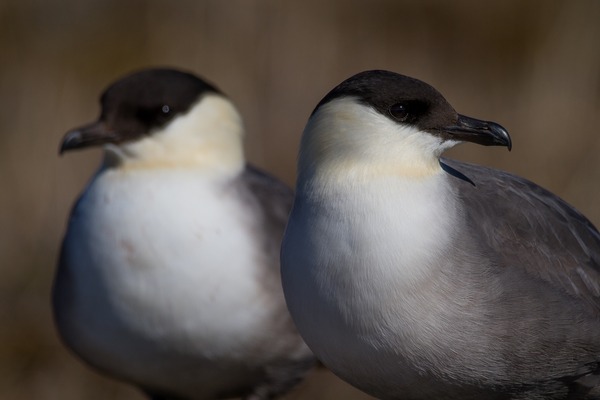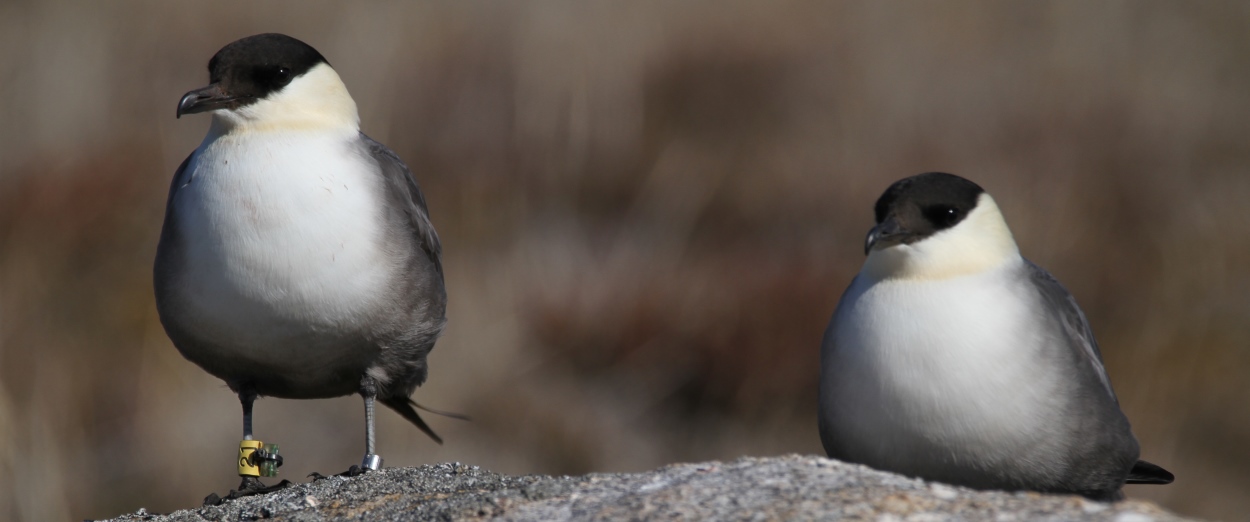 LINKED PAPER
LINKED PAPER
High site and mate fidelity in a monogamous Arctic seabird. Seyer, Y., Gauthier, G. & Therrien J.-F. 2022 Ibis. doi: 10.1111/ibi.13132 VIEW
Monogamy is widespread among bird species just like many seabirds are faithful to their mate. Faithfulness may be highly beneficial in long-lived species as it can improve familiarity with a mate. This is especially important to reduce the cost of reproduction (e.g., courtship, territory acquisition, fighting) and improve breeding success. However, divorce may also be beneficial if it allows an individual to pair with a higher-quality mate or to avoid missing a breeding opportunity. Indeed, as seabirds usually remate at the breeding site after spending months separated at sea, synchronicity in arrival time at the breeding site may play a major role in fidelity.
The Long-tailed Jaeger Stercorarius longicaudus (hereafter referred to as Jaeger), a long-distance migratory seabird, spends the non-breeding season in the Southern Atlantic (Seyer et al. 2021) and the breeding season in the Arctic tundra (Seyer et al. 2020). For a long time, Jaegers were assumed to be faithful to their mate and nesting site, but this assertion was never validated with marked individuals…
Using 13 years of Jaeger nest monitoring data on Bylot Island (Nunavut) in the Canadian High-Arctic, we attempted to quantify for the very first time, how faithful they were to their mate and breeding site. Surveying more than a hundred kilometres of transects, every year, over a study area of 60 km2, we monitored 69 breeding pairs which were marked making up 65 different ringed and sexed individuals (30 females, 29 males, 6 unknowns; Seyer et al. 2019).

Figure 1 Ringed Long-tailed Jaeger © 2015 Yannick Seyer.
We found that Jaegers were highly faithful to their nesting site. Indeed, they settled their nest on average 386 ± 56 m from their previous one. An interaction between the nesting success in the previous year and mate fidelity influenced this nest displacement. Jaegers that successfully nested in the previous year (year t-1) moved further if they remated in year t than if they repaired with the same mate as in year t-1 [Figure 2]. Surprisingly, we observed the opposite pattern for individuals that failed nesting. Breeding failure may thus serve as an index of site quality, and this may encourage Jaegers to look for a higher-quality site in the same territory or move to another territory to nest. However, as the pattern was reversed for remated Jaegers, we believe this may be because the challenge of finding a new mate outweighs the potential effects of previous breeding success or because individuals evaluate the performance of their mate and attribute the failure to a poor territory, thus deciding to move further.

Figure 2 Annual nest displacement of Long-tailed Jaeger breeding pairs (n = 35) on Bylot Island, Nunavut, based on nesting success in the previous year and mate fidelity (black: mate retained; grey: remated). Error bars represent the 95% confidence intervals.
Our 65 ringed Jaegers allowed us to estimate that 79% of the males and 85% of the females retained their mate between years. Considering Jaegers have an annual survival rate of 91% (Julien et al. 2013), we could estimate that potentially 12% of males and 6% of females divorced annually, and that the remaining 9% were widowed. Despite our tremendous annual field efforts, among all individuals that changed mates, we could only confirm one case of divorce where both pair members returned to the study site and mated with a different individual in subsequent years. Nevertheless, our divorce rate was similar to what was observed in other Stercorariidae and lower than the median for seabirds estimated by Mercier et al. (2021).

Figure 3 Pair of Long-tailed Jaegers © 2015 Yannick Seyer.
After having monitored the nest of the ringed Jaegers, we concluded that neither nest displacement nor mate faithfulness affected the laying date and nesting success. Although this may be quite surprising as divorce is often associated with a delayed laying date and reduced nesting success, it suggests that remating for Jaegers can be done at a low cost. Perhaps, Jaegers may start searching for a new mate shortly after arrival at the breeding ground to avoid delaying reproduction and ultimately missing a breeding opportunity. Moreover, in a previous study (Seyer et al. 2021), we observed that mates arrived on average 5 days apart at the breeding site. Accordingly, the formation of a new pair is believed to be based on temporal assortative mating, allowing synchronicity in arrival in subsequent years.
Our study showed that remated Jaegers did not suffer from reduced nesting success compared to faithful pairs. The similarities in roles and investment in reproduction between mates, and the acquisition of food performed in a small inland territory, may reduce the costs of remating. This may help to reduce any inefficiencies associated with breeding with a new mate, which is often encountered in seabirds that need to synchronize incubation and chick-rearing duties.

Figure 4 Pair of Long-tailed Jaegers sharing a Brown Lemming (Lemmus trimucronatus) © 2019 Yannick Seyer.
In the end, the short summer and high unpredictability of resources of the Arctic tundra probably favour high site and mate fidelity in Long-tailed Jaegers while they can remate at low cost whenever it is needed.
References
Julien, J.-R., Gauthier, G., Morrison, R.I.G. & Bêty, J. 2013. Survival rate of the Long-tailed Jaeger at Alert, Ellesmere Island, Nunavut. Condor 115: 543-550. VIEW
Mercier, G., Yoccoz, N.G. & Descamps, S. 2021. Influence of reproductive output on divorce rates in polar seabirds. Ecology and Evolution 11: 12989-13000. VIEW
Seyer, Y., Gauthier, G., Bernatchez, L. & Therrien, J.-F. 2019. Sexing a monomorphic plumage seabird using morphometrics and assortative mating. Waterbirds 42: 380-392. VIEW
Seyer, Y., Gauthier, G., Bêty, J., Therrien, J.-F. & Lecomte, N. 2021. Seasonal variations in migration strategy of a long-distance arctic-breeding seabird. Marine Ecology Progress Series 677: 1-16. VIEW
Seyer, Y., Gauthier, G., Fauteux, D. & Therrien, J.-F. 2020. Resource partitioning among avian predators of the Arctic tundra. Journal of Animal Ecology 89: 2934-2945. VIEW
Image credit
Top right: Pair of Long-tailed Jaegers (Stercorarius longicaudus) © 2015 Yannick Seyer.
If you want to write about your research in #theBOUblog, then please see here.




